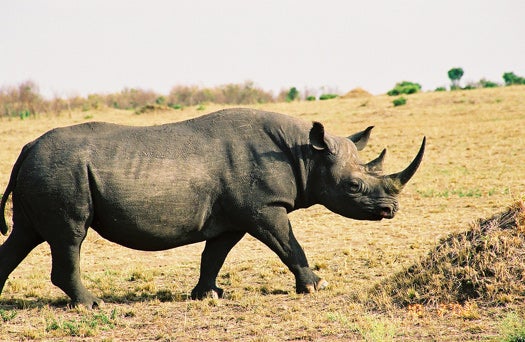Inject Rhino Horns With Poison, That’ll Stop Poachers
Poison, dye, and GPS chips. Poachers, you've been warned: these are not the horns you want.

In South Africa, conservationists have had to come up with new and more innovative ways to prevent poachers from killing the local rhinoceros for their horns. Enter the Rhino Rescue Project.
The trade in rhino horns is immensely profitable; rhinos are huge but not particularly hard to kill, since they need a lot of water and can be reliably found at watering holes. The horns are powdered and used in traditional Chinese medicine, prescribed for fevers and convulsions (not as an aphrodisiac, as is sometimes thought). So the Rhino Rescue Project began investigating something unorthodox: why not make the horns unusable as medicine?
There’s a multi-pronged method here. Materials are not exactly injected but rather, as the Rhino Rescue Project says, “infused into the horn using a patented high-pressure device.” No more detail is given about how that works. But the device uses a dye which turns the horn brightly and irrevocably pink, kind of like the dye used in ink packs to secure money at a bank. That makes it useless as a prize or ornament, and even if the horn is ground to a fine powder, it’ll still show up in an airport security scanner. Three separate GPS chips are implanted into the horn, kind of like this older project–it’s worth mentioning here that a rhino’s horn is made of keratin, just like your fingernails, and the animal feels no pain during any of this. And the dye has no adverse health effects on the rhino.
In the future, the project even plans to add poison–ectoparasiticides, to be exact, which are damaging to neither the rhino nor any animal in the rhino’s ecosystem, like ox-pecker birds. But for humans, it’s pretty toxic, causing extreme nausea, vomiting, convulsions, and more. So: make it non-desirable to poach (by making it pink), make it hard to move (because it’s pink, also because of the GPS trackers and the dye’s visibility in scanners), and then make it useless for medicine (because it’ll make you sick).
The project is still in the testing phase, but it’s very promising stuff.
[via PSFK]